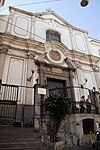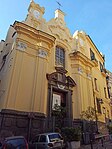Certosa di San Martino

The Certosa di San Martino ("Charterhouse of St. Martin") is a former monastery complex, now a museum, in Naples, southern Italy. Along with Castel Sant'Elmo that stands beside it, this is the most visible landmark of the city, perched atop the Vomero hill that commands the gulf. A Carthusian monastery, it was finished and inaugurated under the rule of Queen Joan I in 1368. It was dedicated to St. Martin of Tours. During the first half of the 16th century it was expanded. Later, in 1623, it was further expanded and became, under the direction of architect Cosimo Fanzago, essentially the structure one sees today. In 1799 anti-clerical French forces of occupation suppressed the monastery and forced the monks to flee. In the ensuing decades the monks made several attempts to reestablish their charter house, with the last effort failing in 1866, when the state definitively confiscated the property. Today, the buildings house the National Museum of San Martino with a display of Spanish and Bourbon era artifacts, as well as displays of the presepe—Nativity scene—considered to be among the finest in the world.
Excerpt from the Wikipedia article Certosa di San Martino (License: CC BY-SA 3.0, Authors, Images).Certosa di San Martino
Largo San Martino, Naples Vomero
Geographical coordinates (GPS) Address Nearby Places Show on map
Geographical coordinates (GPS)
| Latitude | Longitude |
|---|---|
| N 40.843333 ° | E 14.24124 ° |
Address
Museo nazionale di San Martino
Largo San Martino
80100 Naples, Vomero
Campania, Italy
Open on Google Maps











